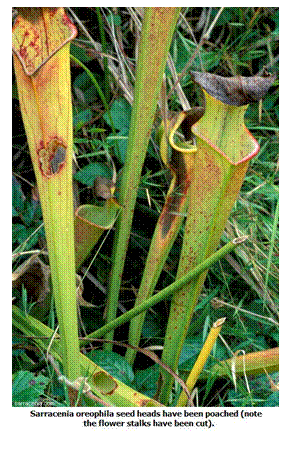Problem Specifics
All the threats that face Sarracenia can be connected to human
activity in some form. One of the major threats to the genus is habitat
degradation and habitat loss. Because Sarracenia
are heavily reliant on high water 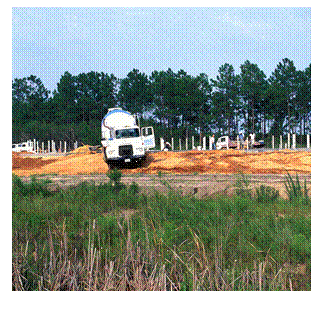 tables, activities
such as wetland draining and land development are posing major problems. As
development occurs in the Eastern US, wetlands are being drained and water
tables begin to drop. In addition, soil chemistry, pH, and composition changes
because of this. Sarracenia are
perfectly adapted to poor soils. When organic material is allowed to be broken
down into nutritive molecules and to accumulate because of the absence of the
flowing water, the soil becomes nutrient-rich. Sarracenia roots begin to die in the presence of rich soil and the
plants ultimately die. The change in hydrology due to development also alters
the natural ranges of Sarracenia
species. In some cases, the ranges of species like Sarracenia oreophila have ended up being fragmented. Not only this,
but the direct development of the land has posed serious issues. Donald Schnell
accounts how several plants were bulldozed over as construction workers
prepared the land to lay down pavement on a North Carolina site (Rice, 2006 and
Stucky, 1999).
tables, activities
such as wetland draining and land development are posing major problems. As
development occurs in the Eastern US, wetlands are being drained and water
tables begin to drop. In addition, soil chemistry, pH, and composition changes
because of this. Sarracenia are
perfectly adapted to poor soils. When organic material is allowed to be broken
down into nutritive molecules and to accumulate because of the absence of the
flowing water, the soil becomes nutrient-rich. Sarracenia roots begin to die in the presence of rich soil and the
plants ultimately die. The change in hydrology due to development also alters
the natural ranges of Sarracenia
species. In some cases, the ranges of species like Sarracenia oreophila have ended up being fragmented. Not only this,
but the direct development of the land has posed serious issues. Donald Schnell
accounts how several plants were bulldozed over as construction workers
prepared the land to lay down pavement on a North Carolina site (Rice, 2006 and
Stucky, 1999).
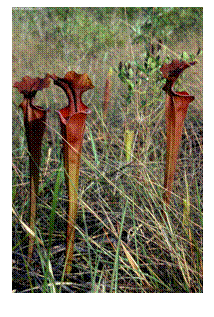 Another
threat to Sarracenia is water
pollution. Sphagnum moss, the main component of peat bogs, is highly sensitive
to impure water. Any alien chemicals or change in the water TDS (total
dissolves solids) level is enough to kill the sphagnum moss. Water in the
habitat of these plants has been affected with increase in agricultural runoff,
uses of general pesticides, and human pollution. As a result, many populations
of Sarracenia species have begun to
decrease in size and quality (Rice, 2006).
Another
threat to Sarracenia is water
pollution. Sphagnum moss, the main component of peat bogs, is highly sensitive
to impure water. Any alien chemicals or change in the water TDS (total
dissolves solids) level is enough to kill the sphagnum moss. Water in the
habitat of these plants has been affected with increase in agricultural runoff,
uses of general pesticides, and human pollution. As a result, many populations
of Sarracenia species have begun to
decrease in size and quality (Rice, 2006).
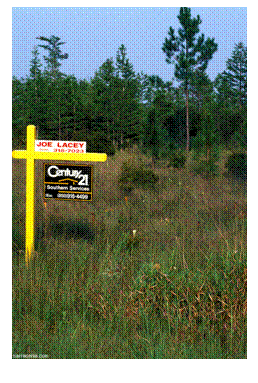 Next, Sarracenia are threatened by fire suppression. Many carnivorous
plants are adapted to small and frequent fires. The fires usually eliminate
large woody growth as well as dead vegetation left over from annual plants in
their habitats. When fire suppression is practiced, large vegetation is allowed
to grow and accumulate. This usually ends up displacing Sarracenia as well as physically covering them with foliage. This
results in the reduction of photosynthesis carried out by the plant, and can
eventually kill the plant (Schnell, 1982 and Rice, 2006).
Next, Sarracenia are threatened by fire suppression. Many carnivorous
plants are adapted to small and frequent fires. The fires usually eliminate
large woody growth as well as dead vegetation left over from annual plants in
their habitats. When fire suppression is practiced, large vegetation is allowed
to grow and accumulate. This usually ends up displacing Sarracenia as well as physically covering them with foliage. This
results in the reduction of photosynthesis carried out by the plant, and can
eventually kill the plant (Schnell, 1982 and Rice, 2006).
Lastly, poaching has become a growing
problem for Sarracenia. People that
go into Sarracenia habitat and
collect wild specimens are poachers. Since all Sarracenia are listed under the CITES appendices, it is illegal to
collect them from the wild and distribute or sell those wild-collected
specimens. Most of these people do this in order to sell off the specimens into
the carnivorous plant hobby. Some specimens have been shipped overseas out of
the US as well. This brings up the question, is not the carnivorous plant hobby
just hurting Sarracenia and other
threatened and endangered carnivorous plants? The subject is controversial,
however most carnivorous plants growers are very well aware of the conservation
issues that these plants face. In fact, many growers are the best
conservationists for the plants as they are the ones that help educate others
about the plants as well as being those that help organizations that aid Sarracenia conservation efforts. Most
have formed groups that focus on finding Sarracenia
locations in the wild and many help identify poached plants and sometimes the
poachers and illegal vendors. Most of the plants in the hobby have been
produced via tissue culture, asexual rhizomic divisions of other captive
plants, or grown from seed. Therefore, these plants are legal to have in
captivity. Many have also been introduced to the hobby by botanic gardens and
conservancies. Because of poaching, many natural Sarracenia habitat sites are not disclosed; not even to hobbyists
because of fear that the location information may make it to the hands of
poachers (Schnell, 2002 and Rice, 2006 and ---, 1998).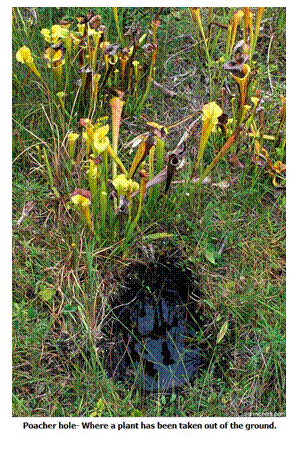
Currently there are three Sarracenia species listed under CITES
Appendix I, S. oreophila, S. alabamensis, and S. jonesii. The latter two are subspecies of S. rubra, but are seen and categorized as separate species by some
botanists. All other Sarracenia
species are listed under Appendix II. The three mentioned Sarracenia are federally listed under the Endangered Species List
in the US as well. This means that these three species have both protection in
the US and on an international level. Heavy restrictions and penalties exist
for collection and transport of these plants as well as specimens that are
already in cultivation. The loss of these species will ultimately lead to the
loss of other species that are unique to peat bogs and other wetland habitats.
For some Sarracenia like S. alabamensis populations are heavily
and very rapidly decreasing. The number of sites that house these species are
degrading and disappearing. Without adequate conservation efforts, those plants
that are most threatened as well as other, less threatened Sarracenia will most likely decline very rapidly (Godt, 1996 and
Schnell, 2002).
